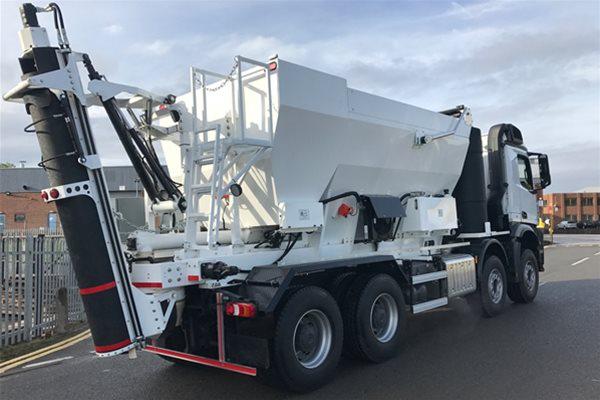New Volumetric Legislation: A Utranazz Guide

In December 2017, the UK Government’s Department for Transport announced a number of decisions concerning the regulated weight limits for volumetric concrete mixers. This led to the regulations for volumetric concrete mixers being converged with the regulations that apply to heavy goods vehicles (HGVs) from 1st September 2018.
To read their open letter published in April 2018, click here.
This guide will detail the changes, how this may affect you, and what you should do next.
What’s changed?
Before the change in regulations, volumetric concrete mixers (sometimes referred to as mobile (concrete) batching plants) were defined as engineering plant rather than as goods vehicles.
This meant that operators and drivers did not require an operator’s licence, there was no application of drivers’ hours or working time rules, and there was no apparent requirement for HGV licences either. This classification meant that volumetric concrete mixers on UK roads could operate according to their chassis design weight, essentially allowing four-axle rigid volumetrics to be loaded well in excess of 40 tonnes when HGVs were limited to 32 tonnes.
The new legislation has ruled that, as of 1st September 2018, volumetric mixers now come under the goods vehicle operator licensing regime. This means that operators of volumetric mixers must now ensure compliance with:
- Drivers’ hours
- Tachograph rules
- Operator licences
- Working times
- HGV licences
- Vehicle weight limits
Volumetric concrete mixers are now also required to undergo HGV annual testing from 20th May 2018.
How will this affect you?
Vehicle Special Order
As an operator of a volumetric concrete mixer, you will have to be aware of the weight of the load your volumetric is carrying. A temporary arrangement has been put in place, however, to allow these vehicles to continue to operate above the standard legal weight limits while operators transition their vehicles to comply with the new regulations.
In order to operate above the standard legal weight limits, you will have to apply for a Vehicle Special Order, or VSO. This Order will be issued on a per-operator basis and will cover all relevant vehicles in the fleet. A VSO application should be marked as in relation to mobile concrete batching plants and must include the following information for each vehicle in the fleet that you wish the VSO to apply to:
- Vehicle make
- Vehicle model
- Registration number
- Vehicle identification number
- Number of axles
The VSO will be applicable for any given vehicle until whichever of the following occurs first:
- the 12th anniversary of the vehicle’s first registration,
- or 31st March 2028.
All applications to subsequently add newly registered vehicles to the VSO must be made by the end of 2018, after which they will be subject to standard AWR weight limits and will not be eligible to operate under a VSO.
Weight Limits
The following gross weight limits will apply to the relevant volumetric concrete mixer design configuration (number of axles) in place of the usual gross vehicle weights specified in Schedule 1 (parts I and II) to the Road Vehicles (Authorised Weight) Regulations 1998 (“AWR”)1. For all other design configurations, the usual AWR requirements will apply.
- 2-axle rigid: 21.6 tonnes
- 3-axle rigid: 31 tonnes
- 4-axle rigid: 38.4 tonnes
- 5-axle rigid (or more than 5-axle rigid): 44 tonnes
In addition, the gross weight of the vehicle must not exceed 6 tonnes per metre of the distance between the front and rear axle. Schedule 3 to the AWR (axle weight limits) shall not apply but the axle weight limits in Schedule 3 shall not be exceeded by more than a factor of 20%.
Licencing
Due to the significant quantities of cargo carried by volumetric concrete mixers and their introduction into the annual testing regime, these vehicles will require “O” licencing from 1st September 2018.
According to a document released by the Road Haulage Association, volumetric concrete mixers can continue to be driven on a Category “B” driving licence, and drivers will not need a Driver’s CPC (Certificate of Professional Competence).
Despite the engineering plant terminology, the DVSA has viewed volumetric concrete mixers as always having been goods vehicles for the purposes of EC drivers’ hours and tachograph legislation, and so a tachograph will be a requirement for the operation of these vehicles.
What should you do next?
Now that the legislation has passed, you must ensure that all of your vehicles meet the above requirements. If you need to apply for a VSO, make sure that you get your application completed and sent before the end of the year.
If you already have a VSO, you should start considering how you will meet the weight limits applicable to other heavy goods vehicles by the time it runs out, whether that is 31st March 2028 or the 12th anniversary of your vehicle’s first registration.
If you are an operator, you must make sure you have the correct licencing for your vehicles, and drivers must abide by the EU’s drivers’ hours and working time rules.
If you have any further questions regarding the changes in legislation and how they will affect you, please contact the DVSA, the DVLA, or visit gov.uk.